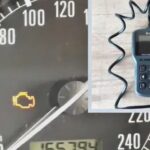The evolution of On-Board Diagnostics (OBD) systems has revolutionized automotive repair and maintenance. Understanding the key differences between OBD1 and OBD2 Engine Control Units (ECUs) is crucial for anyone working with vehicles. This article delves into the core distinctions between these two generations of diagnostic systems, focusing on their impact on ECU interaction and vehicle diagnostics.
OBD1: The Precursor to Modern Diagnostics
OBD1, introduced in the 1980s, represented the first attempt at standardizing vehicle diagnostics. However, this early system lacked uniformity across car manufacturers. Each manufacturer employed proprietary connectors, communication protocols, and data interpretation methods. This lack of standardization made cross-compatibility a significant challenge for mechanics. OBD1 primarily focused on monitoring emissions-related components and provided limited diagnostic capabilities. Accessing and interpreting data often required specialized equipment for each vehicle make and model. Furthermore, OBD1 systems typically only stored fault codes after a problem had occurred, offering little in the way of preventative maintenance.
OBD2: The Standardized Diagnostic Revolution
OBD2, implemented in the mid-1990s, addressed the shortcomings of its predecessor by introducing a universal standard for diagnostics. This standardization encompassed connectors, communication protocols (e.g., J1850, ISO9141-2, CAN), and Diagnostic Trouble Codes (DTCs). The universal 16-pin OBD2 connector simplified diagnostic procedures, allowing technicians to use the same tools across different vehicle makes and models. OBD2 expanded diagnostic capabilities beyond emissions, providing access to a wider range of vehicle systems including engine, transmission, ABS, and airbags. Real-time data monitoring enabled proactive identification of potential issues before they escalated into major problems.
Key Differences in ECU Interaction
The core Difference Between Obd1 And Obd2 Ecus lies in their communication and data handling. OBD1 ECUs relied on manufacturer-specific protocols, limiting access to data and requiring specialized tools. OBD2 ECUs, utilizing standardized protocols, facilitate seamless communication with generic OBD2 scanners. This standardization allows for easier retrieval and interpretation of diagnostic data, empowering technicians to troubleshoot a broader range of issues more efficiently.
Impact on Tuning and Diagnostics
The shift to OBD2 significantly impacted vehicle tuning and diagnostics. OBD1’s proprietary nature made tuning more complex, often requiring specialized knowledge and equipment. OBD2’s standardization opened up tuning possibilities, allowing for more accessible and user-friendly tuning options using generic OBD2 interfaces. In terms of diagnostics, OBD2’s comprehensive data access and standardized DTCs revolutionized troubleshooting. Mechanics gained the ability to quickly and accurately diagnose a wider range of vehicle problems, significantly improving repair efficiency.
Conclusion
The transition from OBD1 to OBD2 marked a pivotal advancement in automotive technology. The standardization introduced by OBD2 transformed ECU interaction, simplifying diagnostics and tuning processes. While OBD1 served as a crucial foundation, OBD2’s universality and expanded capabilities have made it the cornerstone of modern vehicle diagnostics and repair. Understanding these differences is essential for anyone involved in automotive maintenance and repair.

